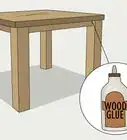This article was co-authored by Priscilla Bettencourt. Priscilla Bettencourt is an Home Stager, Interior Designer, and the Founder of Halcyon Home Staging + Design, a home staging business based in San Francisco, California. Halcyon specializes in expansive staging services geared to maximize a property's resale value and transform any home into an inviting environment for potential buyers. Halcyon has received the “Best of Houzz Service” Award in 2017, 2018, 2019, and 2020.
There are 19 references cited in this article, which can be found at the bottom of the page.
This article has been viewed 25,807 times.
If you're looking for new wood furniture, you likely want to pick something that lasts, so it doesn't break down in a few years. To pick furniture that will last, you need to be able to judge the quality of that furniture. When looking for quality wood furniture, you first need to consider the wood type and whether it is durable. You'll also need to look for other signs of quality, such as better joint construction and stability. You also need to know what to avoid, such as low quality joints and wood with cracks or knots.
Steps
Distinguishing Quality by Wood Types
-
1Look for solid wood. If a store claims that a piece of furniture is solid wood, that means that it only contains wood. Plywood, on the other hand, is layers of wood and resin or glue. Solid wood tends to be more durable, though it is usually more expensive.[1]
- If you can see an unfinished edge of the furniture, you should be able to tell if it's plywood or solid wood. Plywood will have visible layers.
-
2Expect nine layers or more if you choose plywood. Plywood can be pretty solid and last a good amount of time, as long as it contains enough layers. Look for nine or more layers when examining plywood furniture. You should be able to count layers on an exposed side.[2]
- For instance, if you're looking at a dresser, look at where the joints come together (such as in the back), which should have an edge where you can see the plywood layers.
Advertisement -
3Look for veneer. Veneer is when a cheaper wood is covered with a thin layer of higher quality wood. It's not as good a quality as solid wood, but solid, beautiful pieces can be made out of veneer. In fact, you can even sand and re-stain these pieces, though you don't want to sand too much, as you can wear through the veneer layer.
- Veneer actually doesn't split as much as hardwood. On the other hand, you may get blistering over time, or the veneer may start to peel up.[3]
- When choosing veneer, look for a thin veneer layer rather than thick veneer. Thick veneer is more likely to split. You'll be able to to tell on the edges. Thick veneer will be visible.[4]
-
4Know your woods. Each type of wood has something different to bring to the table. Some woods are cheap and plentiful, while others will stand the test of time more readily. If you know the type of wood the furniture is made out of, you know a bit more about it's quality. "Hardwood" and "softwood" more often refer to the type of tree than the durability of the wood, so pay attention to the type of wood instead.[5]
- For instance, pine is cheap, so it's used fairly often. However, it's relatively soft, so it dents and dings easily.[6]
- Oak is hard-wearing. It also has a distinctive, visible grain, so you need to appreciate the look.[7] Walnut is also hard-wearing, but it has a variation in color that may or may not be to your taste.[8]
- Cherry is a more expensive wood, due to its fine grain and beautiful color.[9] Maple is not as expensive, but it is extremely durable. It is also easy to stain any color you'd like. Mahogany is more expensive than maple, and it is also a quality wood.[10]
Paying Attention to Other Signs of Quality
-
1Look at the finish. The finish should be even across the whole piece, making a nice, uniform color. If it's not, that could indicate the piece has been cheaply done. If the furniture is antique, a few scares are okay, but try to avoid burn marks, which are difficult to repair.[11]
-
2Feel for heft. A better piece of furniture of wood will be heavier than a similar piece that isn't as good a quality. Weight indicates its made out of a better quality wood, like mahogany, rather than a lesser quality wood, like pine.[12]
-
3Check for stability. A good piece of furniture will feel stable. Lean on it or sit on it in several places. Make sure it feels solid. If it wiggles or wobbles, that's likely not good quality.[13] If it's an antique piece, it may have more wiggle, but for the most part, the seller should have fixed that problem.[14]
- It can be hard to tell if wood is good quality by shopping online. Either buy from an online furniture retailer you already trust, or visit a store in-person to examine a piece before you purchase it.[15]
-
4Notice signs of wear. If you're looking for antique furniture, it should have some signs of wear. You should be able to see some dirt in creases, for instance, especially around often used places (such as knobs). If it doesn't have these signs, it's likely been refinished or isn't old.[16]
- Refinished antique furniture isn't necessarily a bad thing, but it won't be worth as much, most likely.
-
5Check the joints. The joints can tell you a great deal about quality. Certain joints, such as dovetail joints and mortise-and-tenon joints, are more stable than other types of joints. If you can identify these joints, you likely have a higher quality piece of furniture.[17]
- A dovetail joint is where two pieces of wood come together with interlocking pieces, secured with glue.[18]
- Mortise-and-tenon joints join when one side of the joint has a long cavity. The other side of the joint is carved to fit into that cavity, sort of like a letter sliding into an envelope. Sometimes, a peg is used to secure the pieces together, and glue is usually added for stability.[19]
Knowing What to Avoid
-
1
-
2Skip staples and nails. Wood should be put together with screws and glue, not staples or nails. Screws will help the furniture last longer because it has a better grip. Glue gives the furniture stability, but you shouldn't be able to see it.[22]
-
3Check for cracks, knots, and other problems with the wood. Cracks in the wood is a sign that it's not very good quality and will likely split at some point. Quality furniture is also made without knots. In addition, check to make sure the wood is hard by lightly scratching the surface (in an inconspicuous place). If it's hard, durable wood, it shouldn't scratch easily.[23]
-
4Avoid drawers that have wood slides. Wood slides won't work as well over time. Look for metal slides, which will hold up better and keep you from shouting at your drawers when they don't want to slide properly.[24]
Expert Q&A
-
QuestionWhere can I buy good wood furniture?
 Priscilla BettencourtPriscilla Bettencourt is an Home Stager, Interior Designer, and the Founder of Halcyon Home Staging + Design, a home staging business based in San Francisco, California. Halcyon specializes in expansive staging services geared to maximize a property's resale value and transform any home into an inviting environment for potential buyers. Halcyon has received the “Best of Houzz Service” Award in 2017, 2018, 2019, and 2020.
Priscilla BettencourtPriscilla Bettencourt is an Home Stager, Interior Designer, and the Founder of Halcyon Home Staging + Design, a home staging business based in San Francisco, California. Halcyon specializes in expansive staging services geared to maximize a property's resale value and transform any home into an inviting environment for potential buyers. Halcyon has received the “Best of Houzz Service” Award in 2017, 2018, 2019, and 2020.
Home Stager & Interior Designer Visit stores in person so you can check the quality of the wood yourself. Opt for trusted brands to get the best quality. Avoid buying wood furniture online because it's hard to gauge the quality.
Visit stores in person so you can check the quality of the wood yourself. Opt for trusted brands to get the best quality. Avoid buying wood furniture online because it's hard to gauge the quality. -
QuestionHow can I buy good quality wooden furniture online?
 Priscilla BettencourtPriscilla Bettencourt is an Home Stager, Interior Designer, and the Founder of Halcyon Home Staging + Design, a home staging business based in San Francisco, California. Halcyon specializes in expansive staging services geared to maximize a property's resale value and transform any home into an inviting environment for potential buyers. Halcyon has received the “Best of Houzz Service” Award in 2017, 2018, 2019, and 2020.
Priscilla BettencourtPriscilla Bettencourt is an Home Stager, Interior Designer, and the Founder of Halcyon Home Staging + Design, a home staging business based in San Francisco, California. Halcyon specializes in expansive staging services geared to maximize a property's resale value and transform any home into an inviting environment for potential buyers. Halcyon has received the “Best of Houzz Service” Award in 2017, 2018, 2019, and 2020.
Home Stager & Interior Designer It's really hard to gauge quality when you're buying furniture online. I recommend purchasing from retailers where you trust their quality versus buying from a big box store where you don't know what you're going to get.
It's really hard to gauge quality when you're buying furniture online. I recommend purchasing from retailers where you trust their quality versus buying from a big box store where you don't know what you're going to get. -
QuestionWhat is the difference between plywood and veneers?
 Community AnswerVeneers are single thickness and plywood is multiple veneers glued together; a veneer is glued to the structure while plywood is the structure. With an applied veneer, a much less permanent glue is used and a veneer can then be removed and replaced more easily (and many detach themselves eventually).
Community AnswerVeneers are single thickness and plywood is multiple veneers glued together; a veneer is glued to the structure while plywood is the structure. With an applied veneer, a much less permanent glue is used and a veneer can then be removed and replaced more easily (and many detach themselves eventually).
References
- ↑ http://www.bhg.com/rooms/dining-room/furniture/ultimate-guide-to-dining-tables/?slideId=4ff3b36b-bd96-4757-aca8-1f2d7f5646f8
- ↑ http://www.getrichslowly.org/images/GRS/furniture_checklist.pdf
- ↑ http://www.bhg.com/rooms/dining-room/furniture/ultimate-guide-to-dining-tables/?slideId=0efa1d91-9d22-4a9a-b203-88b21454b7ae
- ↑ http://www.huffingtonpost.com/2011/11/06/dining-table-buying-guide-how-to-find-the-best-table_n_1078791.html
- ↑ http://lifehacker.com/5918664/what-to-look-for-in-wood-furniture-to-make-sure-you-buy-quality
- ↑ https://www.realsimple.com/home-organizing/decorating/different-types-wood/pine
- ↑ https://www.realsimple.com/home-organizing/decorating/different-types-wood/oak
- ↑ https://www.realsimple.com/home-organizing/decorating/different-types-wood/walnut
- ↑ https://www.realsimple.com/home-organizing/decorating/different-types-wood/cherry
- ↑ https://www.realsimple.com/home-organizing/decorating/different-types-wood/maple
- ↑ https://www.houzz.com/ideabooks/19870300/list/smart-shopper-how-to-judge-antique-furniture-quality
- ↑ https://www.houzz.com/ideabooks/19870300/list/smart-shopper-how-to-judge-antique-furniture-quality
- ↑ http://www.bhg.com/rooms/dining-room/furniture/ultimate-guide-to-dining-tables/?slideId=55087a3a-649f-4558-967a-da35c8fe5dea
- ↑ https://www.houzz.com/ideabooks/19870300/list/smart-shopper-how-to-judge-antique-furniture-quality
- ↑ Priscilla Bettencourt. Home Stager & Interior Designer. Expert Interview. 24 April 2020.
- ↑ https://www.houzz.com/ideabooks/19870300/list/smart-shopper-how-to-judge-antique-furniture-quality
- ↑ https://www.realsimple.com/home-organizing/decorating/furniture-joints
- ↑ https://www.realsimple.com/home-organizing/decorating/furniture-joints/dovetail-joint
- ↑ https://www.realsimple.com/home-organizing/decorating/furniture-joints/mortise-tenon-joint
- ↑ https://www.realsimple.com/home-organizing/decorating/furniture-joints/dovetail-joint
- ↑ https://www.realsimple.com/home-organizing/decorating/furniture-joints/butt-joint
- ↑ http://www.getrichslowly.org/images/GRS/furniture_checklist.pdf
- ↑ http://www.getrichslowly.org/blog/2012/06/13/how-to-buy-quality-furniture/
- ↑ http://www.getrichslowly.org/images/GRS/furniture_checklist.pdf









































































